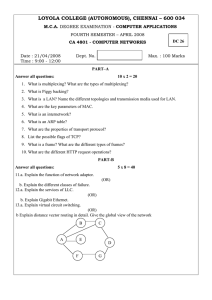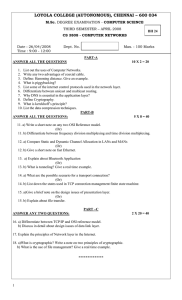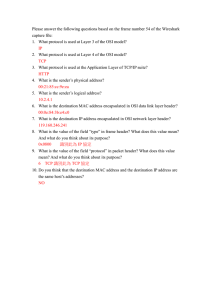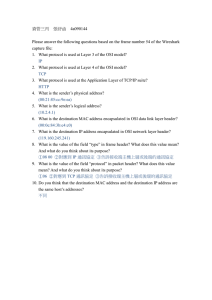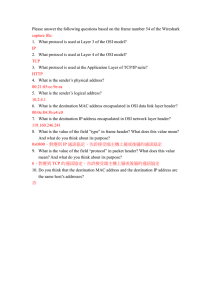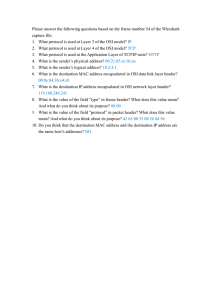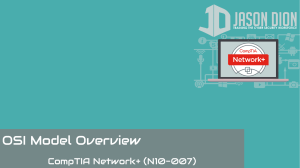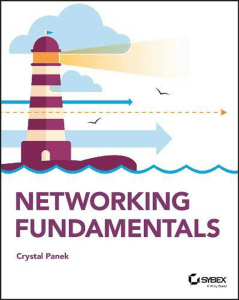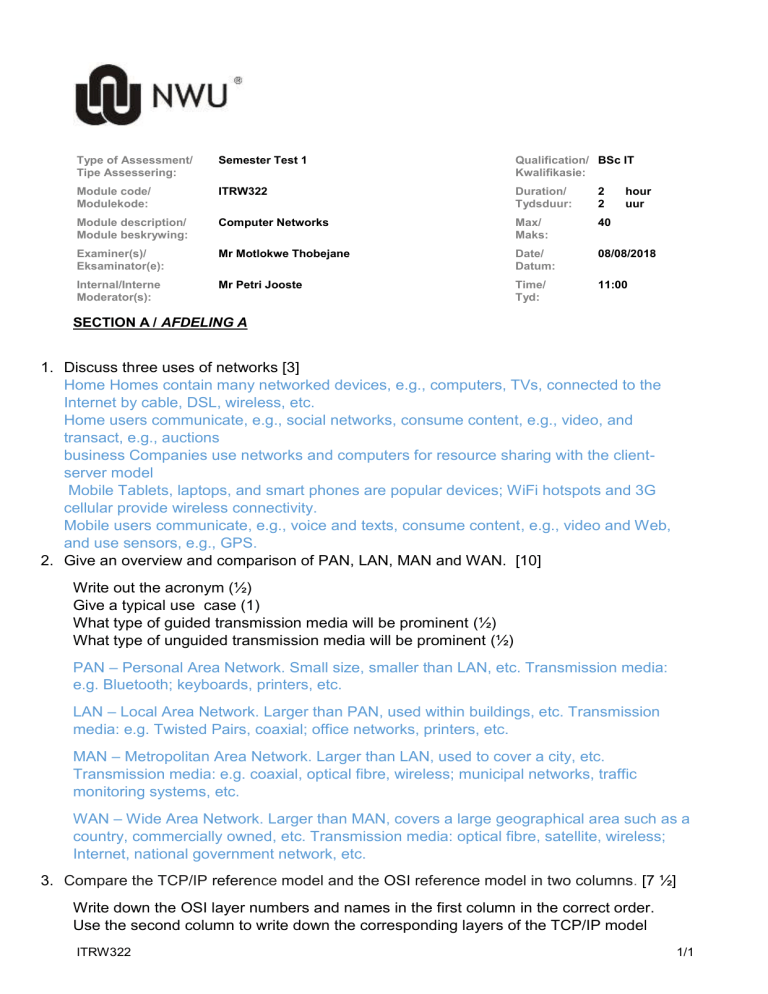
Type of Assessment/ Tipe Assessering: Semester Test 1 Qualification/ BSc IT Kwalifikasie: Module code/ Modulekode: ITRW322 Duration/ Tydsduur: 2 2 Module description/ Module beskrywing: Computer Networks Max/ Maks: 40 Examiner(s)/ Eksaminator(e): Mr Motlokwe Thobejane Date/ Datum: 08/08/2018 Internal/Interne Moderator(s): Mr Petri Jooste Time/ Tyd: 11:00 hour uur SECTION A / AFDELING A 1. Discuss three uses of networks [3] Home Homes contain many networked devices, e.g., computers, TVs, connected to the Internet by cable, DSL, wireless, etc. Home users communicate, e.g., social networks, consume content, e.g., video, and transact, e.g., auctions business Companies use networks and computers for resource sharing with the clientserver model Mobile Tablets, laptops, and smart phones are popular devices; WiFi hotspots and 3G cellular provide wireless connectivity. Mobile users communicate, e.g., voice and texts, consume content, e.g., video and Web, and use sensors, e.g., GPS. 2. Give an overview and comparison of PAN, LAN, MAN and WAN. [10] Write out the acronym (½) Give a typical use case (1) What type of guided transmission media will be prominent (½) What type of unguided transmission media will be prominent (½) PAN – Personal Area Network. Small size, smaller than LAN, etc. Transmission media: e.g. Bluetooth; keyboards, printers, etc. LAN – Local Area Network. Larger than PAN, used within buildings, etc. Transmission media: e.g. Twisted Pairs, coaxial; office networks, printers, etc. MAN – Metropolitan Area Network. Larger than LAN, used to cover a city, etc. Transmission media: e.g. coaxial, optical fibre, wireless; municipal networks, traffic monitoring systems, etc. WAN – Wide Area Network. Larger than MAN, covers a large geographical area such as a country, commercially owned, etc. Transmission media: optical fibre, satellite, wireless; Internet, national government network, etc. 3. Compare the TCP/IP reference model and the OSI reference model in two columns. [7 ½] Write down the OSI layer numbers and names in the first column in the correct order. Use the second column to write down the corresponding layers of the TCP/IP model ITRW322 1/1 OSI layers TCP/IP layers 7 Application Application 6 Presentation 5 Session 4 Transport 3 Network 2 Data link 1 Physical Transport Internet Host to network 4. Discuss the differences between satellite and fiber optics [4] 5. On which OSI layer does each of the following devices perform its main function: [3] Router, Modem, Bridge/Switch. Modem – layer 1; brigde – layer 2; router – layer 3 6. Name and discuss three different services provided by Data link to the Network Layer: [6] Unacknowledged connectionless service. Acknowledged connectionless service. Acknowledged connection-oriented service. 7. For each of the following types of multiplexing: write out the acronym (½), explain how it functions (1) [4 ½] a) TDM b) FDM c) WDM a) FDM (Frequency Division Multiplexing) shares the channel by placing users on different frequencies b) WDM (Wavelength Division Multiplexing), another name for FDM, is used to carry many signals on one fiber 8. Refer to the case of a fast sender and slow receiver to name (½) and explain (1½) the two types of flow control that can be implemented. Feedback-based flow control. • Receiver sends information back to the sender giving it permission to send more data. Rate-based flow control. The protocol generally has a built-in mechanism that limits the rate at which the sender may transmit data. There is no feedback from the receiver. The protocol contains well defined rules about when a sender may transmit the next frame. TOTAL/TOTAAL: 42 MAX: 40 ITRW322 2/1
